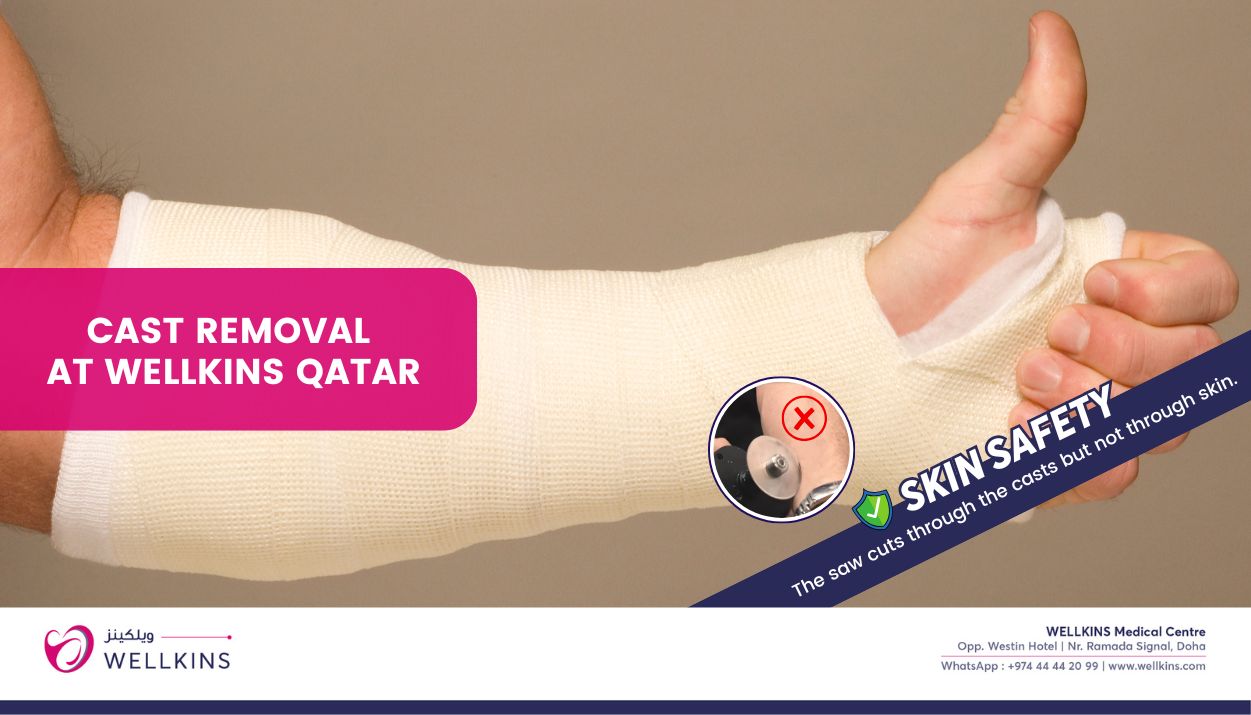Author: Dr.Reneesh (Consultant Orthopedic Surgeon – WELLKINS Medical Centre)
Orthopedic casts play a vital role in immobilizing fractures and supporting the healing process. However, when it’s time to remove the cast, many patients feel apprehensive, particularly about the tools used in the process. As an orthopedic surgeon, I aim to shed light on this routine procedure and alleviate any concerns.
Cast removal is a significant milestone in the healing process after a fracture or injury. It marks the beginning of the rehabilitation phase, where the limb regains its strength and function.
How Is a Cast Removed?
Cast removal:
Cast Removal is a straightforward process carried out by a trained professional. The primary steps include:
Assessment:
The healthcare provider ensures the bone has sufficiently healed by reviewing X-rays or clinical progress.
Cast Cutting:
A specialized cast-cutting saw is used. This tool oscillates rather than rotates, making it effective for cutting the hard cast material but safe on skin. The saw is used to cut along predetermined lines of the cast.
Splitting and Removal:
After cutting, a spreader tool is used to gently open and remove the cast.
Skin Care:
Post-removal, the skin underneath may appear dry or scaly. A gentle cleaning and moisturizing session is usually recommended.
Is the Cast-Cutting Saw Safe?
Yes, the cast-cutting saw is highly safe when handled by professionals.
Here’s why:
Oscillating Mechanism: Unlike traditional saws, the blade of a cast saw oscillates rapidly rather than spinning, which prevents it from cutting soft tissues.
Built-in Safety Features: The saw’s blunt edges and vibration mechanism make it highly unlikely to harm the skin. Patients sometimes feel a vibration or warmth during the process, but it is typically painless.
Why Not to Be Afraid of Cast Removal?
It’s natural to feel anxious, especially for children or first-timers. However, here are reasons to ease your mind:
Painless Process: The procedure is designed to be safe and comfortable.
Experienced Hands: Orthopedic surgeons and technicians have extensive training to perform cast removal efficiently and safely.
Reassurance: You’ll be guided throughout the process, with time to ask questions or voice concerns.

Post-Cast Removal Care Recommendations
Skin and Hair:
Clean the area gently with soap and water. Avoid scrubbing, as the skin may be sensitive.
Apply moisturizer to address dryness.
Rehabilitation:
Start light exercises or physiotherapy as advised to regain strength and mobility.
Avoid heavy activities until full recovery is confirmed.
Watch for Signs:
Swelling, pain, or redness after cast removal may indicate complications. Consult your doctor if these arise.
Safety and Professionalism Matter
Cast removal is a vital part of your recovery journey. Modern tools and professional expertise ensure the process is safe, effective, and hassle-free. Rest assured, your healthcare provider prioritizes your comfort and safety during every step of your treatment.
If you still have concerns about cast removal, speak to your orthopedic specialist—they are here to help!
Read more about the orthopedic services at wellkins here: https://wellkins.com/orthopedics/







